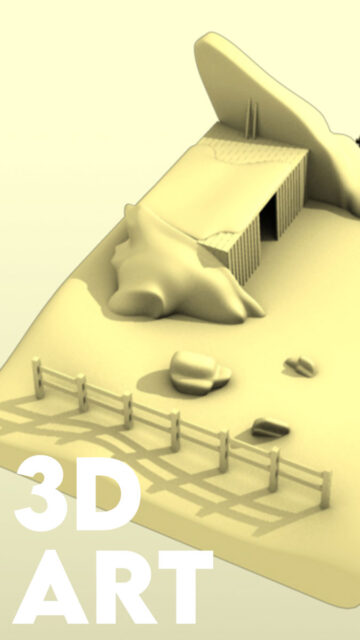Getting into 3D was a pivotal moment for me. This collection brings together my earliest finished works in low poly 3D texturing. These weren’t just learning exercises—they were the first complete outputs of a journey that would shape how I approached art. Even with simple geometry, I discovered how textures could breathe life into every surface.
P-51 Mustang: My First 3D Modeling and Texturing Project
Everything started with the P-51 Mustang.
This was my first full model—from basic mesh to painted textures—completed during my time at the First Academy of Computer Arts. Shaping the fighter plane, unwrapping the UVs, and applying textures helped me understand how each step builds on the last.
The techniques were simple. Even so, seeing it come together as a full render gave me a sense of momentum. That feeling stuck with me.
P-51 Mustang
November 18, 2006
The P-51 Mustang marked my first real venture into 3D modeling and texturing during my time at First Academy of Computer Arts. A simple, heartfelt beginning to my creative journey.
Beginning a Personal Series on Low Poly 3D Texturing
After the Mustang, I turned my focus to environment design.
The Old Well marked the beginning of a small personal series. I explored how textures could tell stories without relying on complex geometry. Aged stones, wooden posts, and hand-laid tiles helped suggest history and atmosphere.
Next came the Lighthouse and Windmill. I leaned on strong silhouettes and detailed textures to imply function and age. For example, the rusted base of the lighthouse or the weathered tiles of the windmill roof helped ground each piece.
These scenes showed me that low poly 3D texturing wasn’t just about surface polish. It was a design tool—just as important as modeling itself.
Ticket Booth and Ferris Wheel: A Move Toward Completeness
Wanting to push further, I started thinking in terms of sets.
The Ticket Booth was my first attempt at a structure that felt placed within a larger space. Through textured walls, floors, and signage, I created a miniature scene that felt useful and grounded.
Then came the Ferris Wheel. I focused on silhouette, lighting, and color to convey a sense of movement—even in stillness. These two models weren’t just objects. Together, they hinted at a narrative, a world beyond the frame.
That’s when I began to see how texture and composition could work hand in hand. Each detail mattered.
Reflections on My First Steps in Low Poly 3D Texturing
Looking back, these early works taught me a lot.
I learned that textures do more than decorate. They anchor your models. Even with low polygon counts, you can suggest mood, time, and material through smart texture work.
More importantly, finishing each piece helped build creative discipline. These weren’t throwaway projects—they were real milestones. Every completed scene was a step forward in learning to communicate visually with constraint and clarity.









